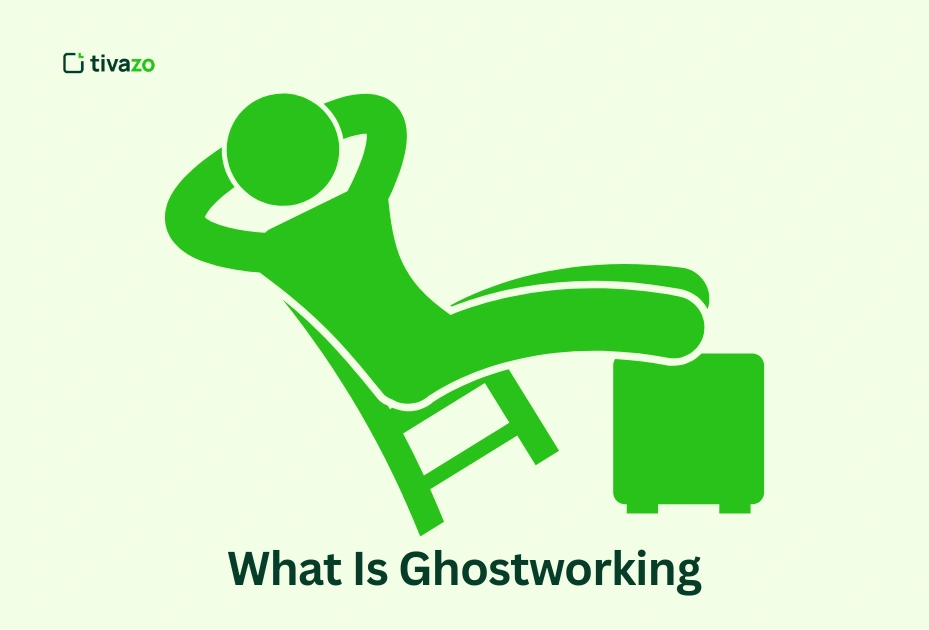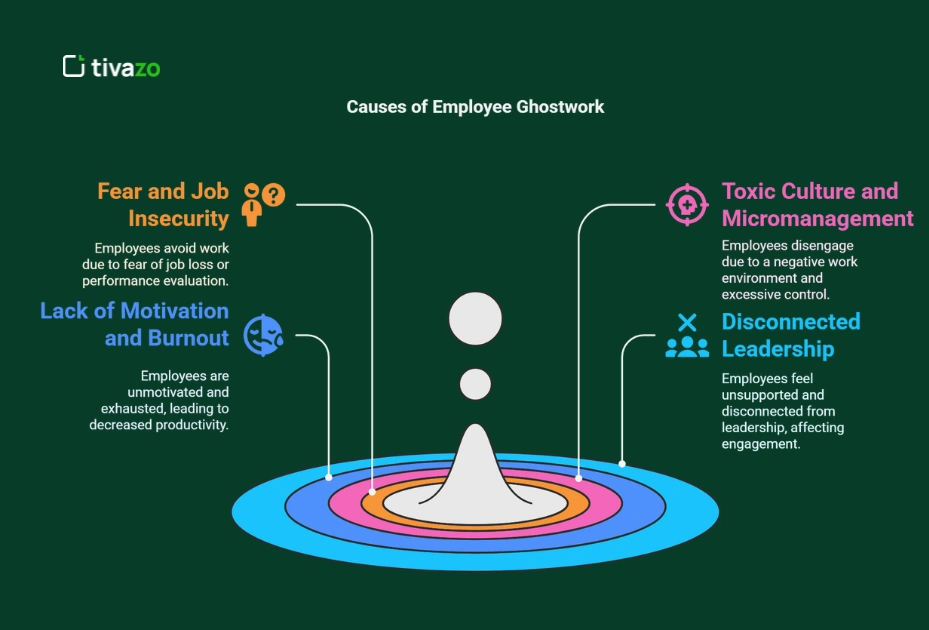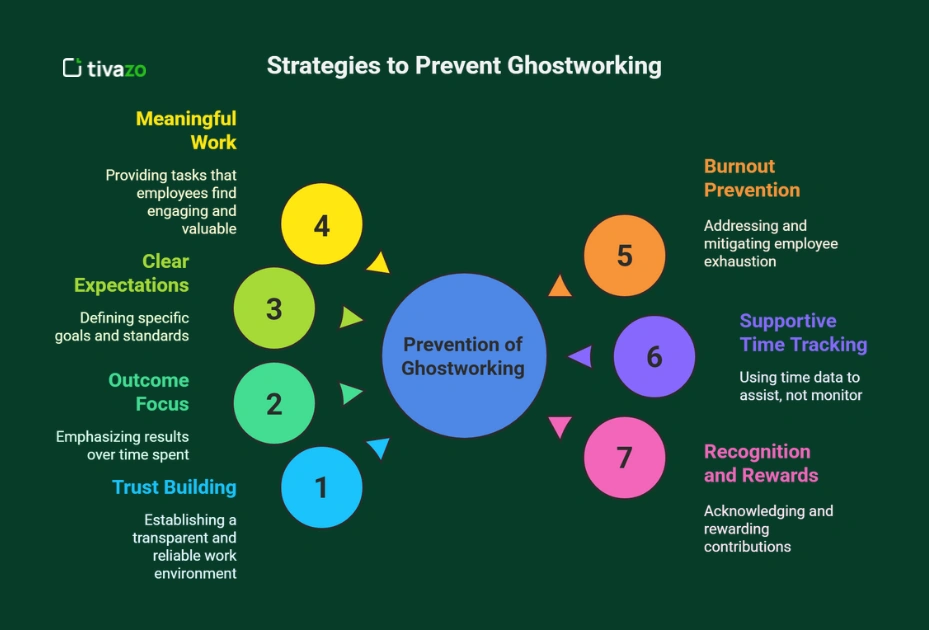In today’s fast-evolving digital workspace, new employee behavior trends are emerging, some of which are undermining productivity silently. One such concerning trend is ghostworking. While it may sound like something out of a Halloween story, ghostworking is a very real phenomenon that can negatively affect workplace performance.
At its core, ghostworking involves employees giving the illusion of being busy without actually contributing value. It thrives particularly in remote and hybrid work environments where visibility is limited and oversight becomes challenging. Alongside closely related trends like quiet quitting and productivity theater, ghostworking is a silent killer of team morale and effectiveness.
This blog will break down the concept of ghostworking, explore its root causes, compare it to similar patterns, and offer practical solutions that managers and team leads can apply to prevent this toxic behavior from growing.
What Is Ghostworking? Understanding the Concept

Ghostworking refers to a growing workplace phenomenon where employees give the appearance of being busy—attending meetings, replying to emails, logging hours—without making meaningful contributions to their work. Unlike simply slacking off, ghostworkers are deliberate in maintaining a facade of productivity. They carefully engage in activities that make them look occupied while avoiding actual outputs or results.
For instance, a ghostworker may join a video call and occasionally unmute to agree with the group but not provide real input. Or they may respond quickly to messages while avoiding deep work tasks. On the surface, everything seems normal. But beneath it, there’s little to no valuable work being done.
Ghostworking is especially hard to detect in remote or hybrid settings, where supervision is more limited, and presence often substitutes for performance.
Ghostworking vs Quiet Quitting

It’s easy to confuse ghostworking with quiet quitting, but the two reflect different employee attitudes and behaviors:
- Ghostworking is about actively maintaining the illusion of productivity while doing minimal actual work. It’s deceptive by design.
- Quiet quitting involves employees doing only what their job descriptions require—no more, no less. It is passive and often stems from boundary-setting or disengagement.
Both are fueled by low motivation, poor engagement, or dissatisfaction, but ghostworking is more insidious because it hides deeper problems behind a veil of busyness.
Why It Matters
While ghostworking may initially seem harmless or even clever, it has far-reaching negative consequences for teams and organizations:
- Poor team morale: When ghostworking becomes visible, it frustrates other employees who are genuinely working hard. Resentment builds, eroding collaboration.
- Decreased overall productivity: Ghostworkers contribute little, which means others must shoulder the burden to keep projects on track.
- Strained workload on team members: When some employees fake productivity, others compensate with overtime or additional responsibilities.
- Misjudged performance metrics: If leaders rely on superficial activity rather than output, ghostworkers may appear as high performers, distorting performance reviews and career progression.
Understanding and addressing ghostworking is not just about correcting behavior—it’s about fostering a healthier, more accountable, and engaged workplace culture.
Why Employees Ghostwork: Root Causes Behind Fake Productivity

Employees don’t typically ghostwork out of laziness. The reasons are often more nuanced and tied to organizational culture, leadership style, and personal circumstances. Here are the core factors that lead to ghostworking:
1. Fear and Job Insecurity
In workplaces with high competition or recent layoffs, employees may fear being labeled unproductive. This fear pushes them to simulate activity—attending meetings, replying to emails promptly—just to appear engaged, even if their work output is minimal. They believe that staying visible helps them retain their jobs.
2. Toxic Culture and Micromanagement
A culture that rewards appearance over results, where managers constantly check in or track hours obsessively, encourages ghostworking. Employees shift their focus to staying busy rather than being effective, leading to a workplace focused more on optics than outcomes.
3. Lack of Motivation and Burnout
Disengaged employees—those feeling undervalued, overwhelmed, or emotionally drained—often ghostwork to cope. Instead of addressing stress or dissatisfaction openly, they go through the motions of work without mental investment. Burnout leads them to conserve energy while maintaining the illusion of contribution.
4. Disconnected Leadership
When managers fail to offer clear guidance, recognition, or two-way communication, employees may feel lost or ignored. In such a scenario, ghostworking becomes a default mode of survival, allowing workers to stay under the radar.
By identifying these root causes, organizations can respond with empathy and strategy—not just enforcement.
Ghostworking in the Era of Remote and Hybrid Jobs
The shift to remote and hybrid work has created new freedoms—but also new challenges. These flexible models allow greater autonomy, yet they also make it easier for ghostworking to go unnoticed.
1. Low Visibility and Less Accountability
When employees aren’t physically present, it’s harder for managers to observe engagement. Some take advantage of this by appearing online, joining meetings, or responding to messages without delivering actual work.
2. Inconsistent Performance Monitoring
In hybrid setups, oversight often varies between in-office and remote workers. This imbalance leads to situations where some employees are held accountable while others slip through the cracks.
3. Post-Pandemic Fatigue
After long stretches of remote work during the pandemic, many employees still struggle with lingering fatigue and lack of motivation. Without strong engagement practices in place, ghostworking can easily fill that void.
4. Communication Gaps
Remote work can lead to reduced face-to-face interaction and fewer spontaneous check-ins. These gaps in communication can cause employees to feel disconnected, overlooked, or unmotivated, making them more prone to ghostworking behavior.
A strong hybrid work culture must address these vulnerabilities to keep productivity real and transparent.
Time Tracking and Productivity Tools: A Double-Edged Sword?
Time tracking tools are often viewed as the frontline defense against ghostworking, but their effectiveness depends largely on how they’re implemented. When used thoughtfully, these tools can offer valuable insights into productivity trends and uncover patterns that reveal mismatches between logged hours and actual work completed.
Benefits:
- Identify gaps between time and output: Time logs can highlight when employees are active but not producing deliverables, helping managers detect ghostworking.
- Monitor long-term behavior trends: Patterns in when and how work is done help managers identify inconsistencies or workflow inefficiencies.
- Inform better decision-making: By turning raw data into actionable productivity metrics, companies can improve task allocation and resource planning.
Drawbacks:
- May encourage surface-level busyness: If misused, tracking tools can pressure employees to look active rather than be effective.
- Erodes trust: Overly strict monitoring can create a culture of surveillance, causing stress and reducing morale.
- Promotes productivity theater: Employees may focus on activities that appear productive just to please metrics instead of contributing real value.
Popular platforms like Tivazo is highly effective in identifying ghostworking only when combined with open communication and a culture that prioritizes outcomes over optics.
7 Proven Ways Managers Can Prevent Ghostworking

Combatting ghostworking requires a proactive, people-focused management approach. Here are seven essential strategies every manager should implement to reduce fake productivity and boost authentic engagement:
1. Build Trust Through Transparency
Trust is the foundation of productive teams. Managers should encourage open conversations and create an environment where employees feel safe discussing workload challenges or engagement issues. Transparent communication not only discourages ghostworking but also strengthens team morale.
2. Focus on Outcomes, Not Hours
Stop equating productivity with hours logged. Instead, assess employees based on outcomes, milestones, and deliverables. When the focus shifts to value rather than presence, ghostworking becomes less rewarding and more difficult to sustain.
3. Define Clear KPIs and Expectations
Employees are more likely to stay accountable when they understand what success looks like. Set measurable Key Performance Indicators (KPIs) that align with business goals. Clearly outlining expectations minimizes ambiguity and reduces the risk of ghostworking slipping under the radar.
4. Encourage Meaningful Work
Help employees understand how their tasks contribute to the bigger picture. A sense of purpose fosters intrinsic motivation and reduces the temptation to ghostwork. Engage team members in projects that align with their strengths and passions whenever possible.
5. Address Burnout Proactively
Ghostworking often stems from exhaustion and disengagement. Managers should monitor workloads, encourage regular breaks, and promote a healthy work-life balance. Creating an environment that prioritizes well-being is one of the most effective ways to prevent ghostworking.
6. Use Time Tracking for Support, Not Surveillance
Time tracking should be seen as a tool for improvement—not punishment. When used collaboratively, it helps identify workflow bottlenecks and provides insights to support resource planning. Ensure employees understand that time tracking is about enhancing productivity, not micromanaging.
7. Recognize and Reward Real Contribution
Acknowledging genuine effort reinforces desired behavior. Celebrate achievements, big and small, and highlight the value of authentic contributions. Recognition boosts morale, builds trust, and reduces the appeal of ghostworking.
Ghostworking vs Quiet Quitting: What’s the Real Threat?
Though both ghostworking and quiet quitting stem from disengagement, their expressions and consequences vary widely.
Ghostworking is a more active form of deception. It allows issues to remain hidden for extended periods, often misleading managers into believing an employee is productive based solely on appearances. This makes it harder to address performance gaps early. Because ghostworkers maintain the illusion of busyness, their lack of contribution can disrupt timelines and drag down overall team performance without detection.
On the other hand, quiet quitting is more passive. Employees stop going the extra mile but still fulfill their basic responsibilities. This behavior highlights problems such as lack of recognition, limited growth opportunities, or poor communication. While quiet quitting is easier to notice and confront, it too reflects disengagement and dissatisfaction.
Why Both Matter:
- Both behaviors diminish the effectiveness of a team.
- Both are symptoms of deeper issues like weak leadership, poor workplace culture, or unmet employee needs.
- Both require proactive, empathetic management, strong communication, and a supportive culture to address and prevent recurrence.
Understanding the difference between the two helps leaders take targeted action. While quiet quitting can often be reversed through engagement and recognition, ghostworking demands more vigilant observation and performance-based accountability.
Conclusion: Building a Culture of Real Work and Accountability
Ghostworking is a modern challenge in an era where remote flexibility and digital communication reign. It not only disrupts productivity but also undermines team trust and business growth.
To combat this, leaders must shift focus from clock-watching to value creation. By promoting work motivation, using tools wisely, and building an inclusive and supportive culture, managers can eliminate ghostworking and uplift team performance.
Ultimately, when real contributions are valued over fake appearances, everyone wins—from the employee to the executive.
FAQs:
What is ghost working?
Ghost working refers to the act of pretending to be productive while contributing little or no actual value. It’s common in remote and hybrid work settings, where employees may log in, attend meetings, or respond to messages but fail to deliver meaningful results.
What is ghosting work?
Ghosting work is a broader term that can refer to employees either disappearing from their responsibilities without notice or, more subtly, going through the motions without engaging with tasks. It overlaps with ghostworking when employees maintain the illusion of presence without output.
How to deal with ghost employees?
To address ghost employees:
- Set clear performance expectations and KPIs.
- Conduct regular check-ins and encourage transparency.
- Use data-driven performance tracking with empathy.
- Promote a culture of recognition and real contribution.
- Address signs of burnout and disengagement early.

